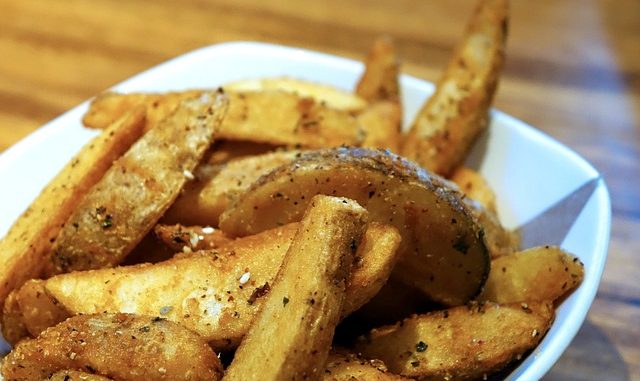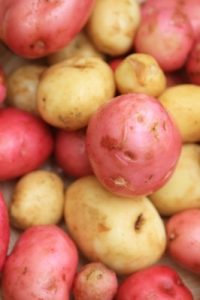
Trying to obtain a steer on the flavours of processed potatoes (Solanum tuberosum L.), whether they are fried, baked, roasted, microwaved or boiled has exercised a number of research groups. It matters to consumers because flavour is paramount with this particular vegetable and yet the many variable flavour attributes are simply not well defined. The subject is extremely well covered by Jansky (2010) who outlines all the major contributions to potato taste and flavour.
Potato Taste And Flavour

Flavour is not only based on the presence of various componentry in the potato matrix but is influenced by genetics – the genotype, by production and storage of the tuber. In a potato as in all foodstuffs, precursors exist which are converted to flavour compounds. They are a mix of sugars, ribonucleic acids (RNAs), lipids and amino acids. One crucial element is the mix or blend between the volatile and non-volatile metabolites, overlaying the changes that occur to each during harvesting, processing and storage. The non-volatiles are mainly contributed by the large number of umami compounds which become noticeable and highly desirable during cooking. The volatiles contribute aroma whilst starch and other carbohydrates contribute texture which impacts our appreciation of flavour.
The volatile that attracted a lot of attention in the late 80s was cis-4-heptenal (Josephson and Lindsay, 1987) which was derived from trans –2,cis-6-nonadienal by a water-mediated retro-aldol condensation reaction. A dilute aqueous solution of cis-4-heptenal generated boiled potato-like aromas. At relatively high concentrations, greater than 0.7 ppb, added cis-4-heptenal contributed a distinct staling-type flavours to fresh, mashed potatoes and reconstituted dehydrated potatoes. When added at levels between 0.1–0.4 ppb, cis-4-heptenal enhanced overall earthy, potato-like flavors in freshly boiled mashed potatoes, but these levels caused stale flavors in reconstituted dehydrated potatoes.
The umami flavour is generally due to ribonucleotides which are the precursors of many flavour potentiators, and potatoes have one of the highest levels of these, the 5’ ribonucleotides, in any plant derived food (Solms and Wyler, 1979). The most important ribonucleotides in flavour development are based on inosine and guanosine. Inosine and guanosine 5’-monophosphate, [(IMP) and (GMP)] are the two main components and their levels vary considerably between potato cultivars (Maga and McNeill, 1986).
What is so intriguing is that the ribonucleotides are present as precursors but are released either by enzymatic hydrolysis and degradation of cellular RNA during cooking. Studies on the steaming and boiling of the Solanum tuberosum Phureja group cultivars which are found mainly in South America, had higher levels of glutamate and guanosine 5′ – monophosphate (GMP) than their Tuberosum counterparts which are mainly grown in Europe. They also recorded better acceptability scores in sensory testing presumably because of this higher release of umami flavours (Morris et al., 2007). Adenosine 5’-monophosphate (AMP) is also another vital component. The different levels of generation of umami flavour are probably due to the differences in initial levels of ribonucleotides and the varying degrees of enzyme activity present in each cultivar.
There is also a synergistic effect between these 5’-ribonucleotides and various amino-acids hydrolysed from proteins, especially glutamate and aspartate. The interactions are believed to be the main reasons for the boiled and fried potato flavour and aroma (Solms and Wyler, 1979; Halpern, 2000).
Sugars are naturally present and form glycoconjugates with glutamate (Beksan et al., 2003) which also contribute to flavour. There are also a number of salts of potassium that enhance umami taste intensity (Ugawa and Kurihara, 1994). Sugars also react via Maillard browning reactions with other amino acids, lipids as well as many ribonucleotides. Enzymes also take part in a variety of Maillard reactions between all this componentry too and cannot be neglected.
Significant levels of potassium leach out of potatoes during boiling (Bethke and Jansky, 2008) which apparently counter the potential rise in flavour impact. It is speculated upon that baked potatoes have a better and more prominent flavour than boiled ones because potassium is retained in the former (Dresow and Böhm, 2009).
We also know that oxidation occurs during cooking because there is a decline in the quantities of antioxidants such as vitamin C (ascorbic acid), various phenolics and carotenoids. Chefs and food manufacturers add antioxidants to maintain flavour and prevent one component – the lipids from degrading too much.
Potato Taste And Lipids
The lipids are very important, especially linolenic acid because of nutritional qualities. Linoleic acid produces oxylipins during storage which then go onto generate aromas during processing. These are hexanal, hydroxyl-, oxo-, hydroperoxy-, and divinyl ether polyunsaturated fatty acids. Lipid breakdown usually through hydrolysis leads most commonly to unpleasant rancid or stale flavours. Stabilization of linoleic and linolenic acids against autoxidation is achieved by treatment with the enantiomeric mixture and pure (+)-methyl jasmonate (Flores et al., 2015). Methyl jasmonate is an interesting molecule – it is released as a defence signal in plants when countering attack, usually by insects but also helps suppress germination and signals other plant specific events.
What isn’t desirable is contamination with bacteria such as Clostridium scatologenes which produces skatole, indole and p-cresol that leaves a farmyard manure taint with potatoes if they are grown in heavily contaminated soil.
All in all without these various interactions we would be denied the creation of the pleasant and desirable characteristic flavours of potato.
1st published 24th December 2014, and revised 30/03/2015
If you are interested in growing these fantastic vegetables we have an article which covers this in some detail.
References
Beksan, E., Schieberle, P., Robert, F., Blank, I., Fay, L.B., Schlichtherle-Cerny, H., Hofmann, T. (2003) Synthesis and sensory characterization of novel umami-tasting glutamate glycoconjugates. J. Agric. Food Chem. 51 (18) pp. 5428 – 5436.
Bethke, P.C., Jansky, S. (2008) The effects of boiling and leaching on the content of potassium and other minerals in potatoes. J. Food Sci. 73 (5): H80 – H85
Dresow, J. F., Böhm, H. (2009). The influence of volatile compounds of the flavour of raw, boiled and baked potatoes: Impact of agricultural measures on the volatile components. Landbauforschung and Forestry Research, 4(59), pp. 309-338.
Flores, G., de la Peña Moreno, F., Blanch, G. P. and Ruiz del Castillo, M. L. (2015), Post-harvest treatment with pure (+)-methyl jasmonate minimizes lipid oxidation in boiled potato (Solanum tuberosum L.). Eur. J. Lipid Sci. Technol. doi: 10.1002/ejlt.201400307
Halpern, B.P. (2000). Glutamate and the flavor of foods. J Nutr. 130 (4) pp. 910s – 914s
Jansky, S. H. (2010). Potato flavor. American Journal of Potato Research, 87(2), pp. 209-217.
Josephson, D. B. Lindsay, R. C. (1987), c4-Heptenal: An Influential Volatile Compound in Boiled Potato Flavor. J. Food Science, 52 pp. 328–331. doi: 10.1111/j.1365-2621.1987.tb06605.x
Maga, J.A. , McNeill, J.G. (1986) Nucleotide composition of incubated potatoes from five potato (Solanum tuberosum) cultivars . Lebensen. Wiss. Technol. 19 (1) pp. 31 – 33
Morris, W.L., Ross, H.A., Ducreux, J.M., Bradshaw, J., Bryan, G.J., Taylor, M.A. (2007). Umami compounds are a determinant of the flavor of potato ( Solanum tuberosum L.). J Agric. Food Chem. 55 pp. 9627 – 9633
Ruiz del Castillo, M. L., Flores, G. and Blanch, G. P. (2010), Exogenous methyl jasmonate diminishes the formation of lipid-derived compounds in boiled potato (Solanum tuberosum L.). J. Sci. Food Agric., 90 pp. 2263–2267. doi: 10.1002/jsfa.4080
Solms, J., Wyler, R. (1979) Taste components of potatoes . In: Boudreau, J.C. (ed.), Food Taste Chemistry . Washington, DC : American Chemical Society, pp. 175 – 184.
Ugawa, T., Kurihara, K. (1994). Enhancement of canine taste responses to umami substances by salts. Am. J. Physiol. 266 pp. 944 – 949
This was a good article for my own web-site.
Yummy chips! I always thought that Yukon potatoes were the best for making fries or chips but I have an issue with lots of carbohydrate generally when it comes to dieting.
There is a very good site on Delicious which does different potato bakes. I also liked the recipe they did for potato wedges. They were fantastic the second time around I made them. Best to add some garlic powder – about 2 teaspoons does for a batch otherwise this ingredient is too overpowering.